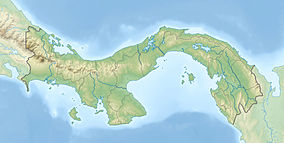| This article needs additional citations for verification. Please help improve this article by adding citations to reliable sources. Unsourced material may be challenged and removed. Find sources: "Coiba" – news · newspapers · books · scholar · JSTOR (November 2013) (Learn how and when to remove this message) |
| Coiba National Park | |
|---|---|
| IUCN category II (national park) | |
 Isla Granito de Oro, Coiba National Park Isla Granito de Oro, Coiba National Park | |
 | |
| Location | Veraguas, Panama |
| Coordinates | 7°29′N 81°47′W / 7.48°N 81.79°W / 7.48; -81.79 |
| Area | 503 km (194 sq mi) |
| Established | 1992 |
| UNESCO World Heritage Site | |
| Official name | Coiba National Park and its Special Zone of Marine Protection |
| Type | Natural |
| Criteria | ix, x |
| Designated | 2005 (29th session) |
| Reference no. | 1138rev |
| State Party | Panama |
| Region | Latin America and the Caribbean |
Coiba (Spanish pronunciation: [ˈkojβa]) is the largest island in Central America, with an area of 503 km (194 sq mi), off the Pacific coast of the Panamanian province of Veraguas. It is part of the Montijo District of that province.
History
| This section needs additional citations for verification. Please help improve this article by adding citations to reliable sources in this section. Unsourced material may be challenged and removed. Find sources: "Coiba" – news · newspapers · books · scholar · JSTOR (August 2023) (Learn how and when to remove this message) |
Coiba separated from continental Panama between 12,000 and 18,000 years ago when sea levels rose. Plants and animals on the new island became isolated from mainland populations and over the millennia most animals have diverged in appearance and behaviour from their mainland counterparts. The island is home to many endemic subspecies, including the Coiba Island howler monkey, and the Coiba spinetail.
In 1919, a penal colony was built on the island and during the years that Panama was under the dictatorships of Omar Torrijos and Manuel Noriega, the prison on Coiba was a feared place with a reputation for brutal conditions, extreme torture, executions and political murders. Nobody knows exactly how many people were killed in the prison during that period, but sources claim that the number could be close to 300. As such, the island was avoided by locals, and other than the prison, was completely undeveloped.
After the prison was closed down in 2004, the island's pristine condition made it ideal as a reserve. It is now said that the prison is haunted by the ghosts of prisoners. One story is that a guard was chasing a prisoner, but the prisoner was a ghost. The guard was so scared that he shot himself. Coiba is also one of the last places in Central America where the scarlet macaw can be found in large numbers in the wild. The island is about 75% forested with a large fraction comprising standing ancient forest. Coiba Island is home to rare flora and fauna found only on the island. The island also harbours tree species that have long disappeared from the mainland due to deforestation and overharvesting.
Coiba National Park
In 1992, Panama created Coiba National Park, encompassing over 1,042 square miles of islands, forests, beaches, mangroves and coral reefs, and in July 2005, Unesco declared it a World Heritage Site.
The park includes Coiba island, 38 smaller islands off the southwest coast of Panama, and the surrounding marine areas within the Gulf of Chiriquí providing protection for coral reefs, humpback whales, pilot whales, killer whales, dolphins, sea turtles, manta rays, marlins and other marine creatures. The park has been designated an Important Bird Area (IBA) by BirdLife International because it supports significant populations of brown-backed doves, Coiba spinetails and three-wattled bellbirds.
Due to the Gulf of Chiriquí's capacity to buffer against the effects of El Niño temperature swings, the marine ecosystems within Coiba National Park harbor a high degree of biodiversity. The park is home to 760 species of marine fishes, 33 species of sharks and 20 species of cetaceans.
References
- "How a Deadly Prison Island Became a Natural Paradise". National Geographic Society. 29 April 2017. Archived from the original on 14 August 2019. Retrieved 7 April 2018.
- Leonard, Thomas M. (2015). Historical Dictionary of Panama. Rowman & Littlefield. p. 81.
- ^ "Coiba National Park and its Special Zone of Marine Protection". UNESCO. Archived from the original on 10 June 2019. Retrieved 25 January 2020.
- "The Coiba National Park, declared a world heritage site by UNESCO". Madrid. 20 July 2005. Archived from the original on 25 January 2020. Retrieved 25 January 2020.
- "Coiba National Park". BirdLife Data Zone. BirdLife International. 2024. Retrieved 2024-09-21.
External links
| National parks of Panama | ||
|---|---|---|
![]() Coiba travel guide from Wikivoyage
Coiba travel guide from Wikivoyage